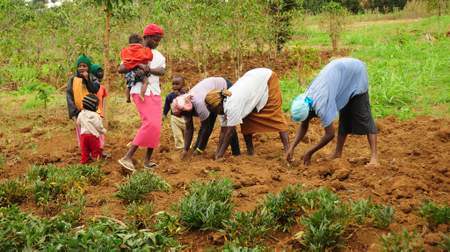-
About
- Our Work
- Get Involved
- Stay Updated
Tending to the real food producers
 45% of households in Africa are led by women
Women are the source of 80% of food produced in countries stricken by famine and malnutrition
however less than 10% [of these] women can access financial resources for farming.
45% of households in Africa are led by women
Women are the source of 80% of food produced in countries stricken by famine and malnutrition
however less than 10% [of these] women can access financial resources for farming.Those were the words of Dr. Lindiwe Sibanda, the keynote speaker at the side event called Empowering women and youth for improved productivity and resilience of African Agriculture at AASW6 organized by FARA.
The role of women in agriculture and their impact on the food security situation in Africa cannot be overstated. On the one hand, they increasingly make up a large proportion of the farming population in many African countries, having virtually taken over food production from men. On the other hand, the increasing withdrawal of mens labour from agriculture in favor of other economic activities ensures that food production remains firmly in the hands of women.
According to an FAO study published in 1995, the contribution of women to food crop production in sub-Saharan African countries ranged from 30% in Sudan to 80% in the Congo, and this is a trend that has been on the rise. Many male farmers would rather invest their energies in a cash crop, and often view food crops as second-class, fit only for women except in cases where the food crop is also a cash crop, as with maize or rice.
Women invest their resources into growing traditional and local food crops (e.g. vegetables, which have been neglected by research and agricultural value chains), thereby not only ensuring food security for Africa but also promoting nutritional security by adding variety and diversity to the food basket of the continent.
Yet, despite all their contributions, women farmers are hardly ever consulted or taken into consideration when decisions on the issues of agriculture, food security and rural development are being considered for policy formulation and implementation by governments and international organizations. All attention is focused on men; their needs, views, challenges and expectations.
Moreover, women are hardly ever really factored into the agricultural empowerment equation. Unlike men, they lack access to land, loans and credit facilities, and, often, an appropriate channel to state their casethey are essentially voiceless. Likewise, government subsidies and loans, when they are available, rarely remain in the hands of the women.
Still, for Africa to be able to truly feed itself, women farmers must be taken seriously and given a real seat at the table by governments, research organizations and other agricultural stakeholders. They must be empowered and supported with the appropriate inputs to upscale their production capabilities and integrate themselves into value-chains so that they get what they deserve for what they produce, thus ensuring the sustainability of their farming businesses.
Beyond powerpoint presentations and beautiful policy drafts on paper, beyond shaking of fists and the clichéd calls for action at conferences and symposiums; getting Africa to actually feed itself will involve mainstreaming, empowering and supporting those who are presently feeding us, who really are ensuring that will do not completely have to depend on other continents for our food needs and most of those are the women farmers of Africa.
Source: Original blogpost by Bunmi Ajilore, a social media reporter for AASW6 on the FARA-AASW blog. He is an agri-blogger at the Ecoagriculturist.
Photo courtesy: Peter Casier/CCAFS
About the author
Related Posts
Comments
No comments made yet. Be the first to submit a commentBy accepting you will be accessing a service provided by a third-party external to https://ypard.net/
Get in touch
Email: [email protected]
YPARD Global Coordination UnitHosted by AGRIDEA and the Czech University of Life Sciences Prague
Lausanne, Switzerland and Prague, Czech Republic - Our Work

 45% of households in Africa are led by women
Women are the source of 80% of food produced in countries stricken by famine and malnutrition
however less than 10% [of these] women can access financial resources for farming.
45% of households in Africa are led by women
Women are the source of 80% of food produced in countries stricken by famine and malnutrition
however less than 10% [of these] women can access financial resources for farming.